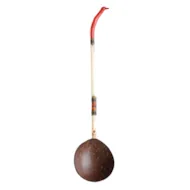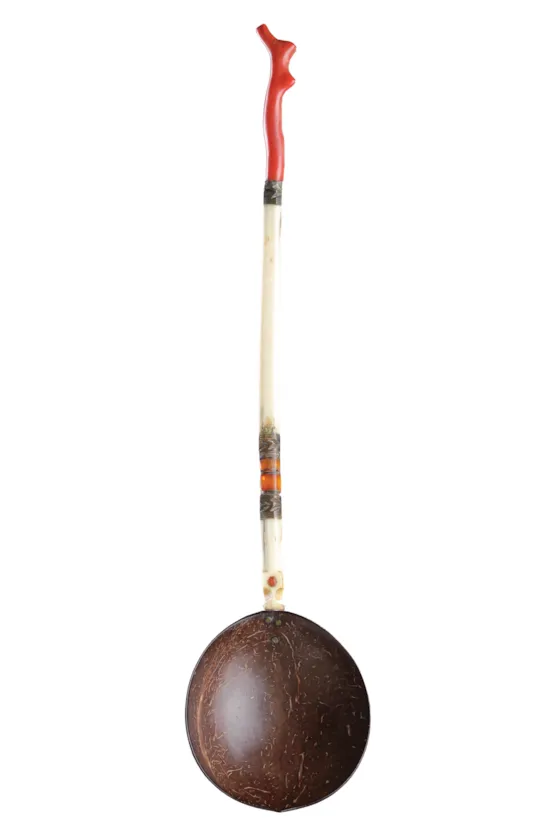A Fine Pair of Ottoman Sherbet Spoons the Bowls made from Coconut Shell Bone Stems with Brass and Enamel Segments with Amber and Coral
A Fine Pair of Ottoman Sherbet Spoons the Bowls made from Coconut Shell
Bone Stems with Brass and Enamel Segments with Amber and Coral
Early 19th Century
Size: 26.5cm long - 10½ ins long and 28cm long - 11 ins long
Bone Stems with Brass and Enamel Segments with Amber and Coral
Early 19th Century
Size: 26.5cm long - 10½ ins long and 28cm long - 11 ins long
A Fine Pair of Ottoman Sherbet Spoons the Bowls made from Coconut Shell
Bone Stems with Brass and Enamel Segments with Amber and Coral
Early 19th Century
Size: 26.5cm long - 10½ ins long and 28cm long - 11 ins long
Bone Stems with Brass and Enamel Segments with Amber and Coral
Early 19th Century
Size: 26.5cm long - 10½ ins long and 28cm long - 11 ins long
These exotic and luxurious spoons were used at table in the Topkapi palace to help oneself from a communal dish of ‘hosaf’, a sort of wet fruit stew, the nearer side of the spoon being used for eating or sipping and the far side for helping oneself. Although knives were employed for cutting up meat, the use of forks was a Western European practice and the use of spoons such as these at table was frowned upon by strictly orthodox Muslims who held that the Prophet found his right hand quite adequate as a tool for eating.
Used by the ladies of the Palace harem, large sets of these spoons were also produced for the use of the Grand Viziers at their meetings in the Divan, the ‘Kubbe Alti’ in the Topkapi Palace in Istanbul. Artists, architects and all manner of skilled craftsmen engaged in all the various branches of the decorative arts were employed within the grounds of the palace using exotic materials from around the world. Rather than relying on placing orders with independent masters, the Ottoman rulers co-opted the best artists they could find into their own palace workshops. Records show that by the end of the 16th century over 1500 craftsmen were on the palace payroll, which by the end of the 18th century had reduced to a mere 186.
Used by the ladies of the Palace harem, large sets of these spoons were also produced for the use of the Grand Viziers at their meetings in the Divan, the ‘Kubbe Alti’ in the Topkapi Palace in Istanbul. Artists, architects and all manner of skilled craftsmen engaged in all the various branches of the decorative arts were employed within the grounds of the palace using exotic materials from around the world. Rather than relying on placing orders with independent masters, the Ottoman rulers co-opted the best artists they could find into their own palace workshops. Records show that by the end of the 16th century over 1500 craftsmen were on the palace payroll, which by the end of the 18th century had reduced to a mere 186.
These exotic and luxurious spoons were used at table in the Topkapi palace to help oneself from a communal dish of ‘hosaf’, a sort of wet fruit stew, the nearer side of the spoon being used for eating or sipping and the far side for helping oneself. Although knives were employed for cutting up meat, the use of forks was a Western European practice and the use of spoons such as these at table was frowned upon by strictly orthodox Muslims who held that the Prophet found his right hand quite adequate as a tool for eating.
Used by the ladies of the Palace harem, large sets of these spoons were also produced for the use of the Grand Viziers at their meetings in the Divan, the ‘Kubbe Alti’ in the Topkapi Palace in Istanbul. Artists, architects and all manner of skilled craftsmen engaged in all the various branches of the decorative arts were employed within the grounds of the palace using exotic materials from around the world. Rather than relying on placing orders with independent masters, the Ottoman rulers co-opted the best artists they could find into their own palace workshops. Records show that by the end of the 16th century over 1500 craftsmen were on the palace payroll, which by the end of the 18th century had reduced to a mere 186.
Used by the ladies of the Palace harem, large sets of these spoons were also produced for the use of the Grand Viziers at their meetings in the Divan, the ‘Kubbe Alti’ in the Topkapi Palace in Istanbul. Artists, architects and all manner of skilled craftsmen engaged in all the various branches of the decorative arts were employed within the grounds of the palace using exotic materials from around the world. Rather than relying on placing orders with independent masters, the Ottoman rulers co-opted the best artists they could find into their own palace workshops. Records show that by the end of the 16th century over 1500 craftsmen were on the palace payroll, which by the end of the 18th century had reduced to a mere 186.
A Fine Pair of Ottoman Sherbet Spoons the Bowls made from Coconut Shell Bone Stems with Brass and Enamel Segments with Amber and Coral






